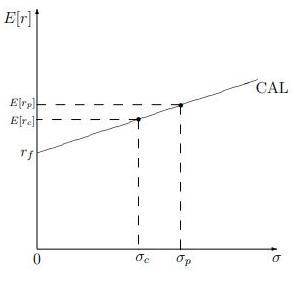
You manage a risky portfolio with an expected rate of return of 18% and a standard deviation of 28%. The T-bill rate is 8%.
A. Your client chooses to invest 70% of a portfolio in you fund and 30% in an essentially risk-free money market fund. What is the expected value and standard deviation of the rate of return on his portfolio?
B. Suppose that your risky portfolio includes the following investments in the given proportions:
Stock A 25%
Stock B 32%
Stock C 43%
What are the investment proportions of your client's overall portfolio, including the position in T-bills?
C. What is the reward-to-volatility (Sharpe) ratio (S) of you risky portfolio? Your clients?
D. Draw the CAL of your portfolio on an expected return-standard deviation diagrm. What is the slop of the CAL? Show the position of your client on your fund's CAL.

Answers: 2
Other questions on the subject: Business

Business, 21.06.2019 16:00, romet31
Danny "dimes" donahue is a neighborhood's 9-year-old entrepreneur. his most recent venture is selling homemade brownies that he bakes himself. at a price of $2 each, he sells 100. at a price of $1.5 each, he sells 300. instructions: round your answer to 1 decimal place. a. what is the elasticity of demand? 3.50 â± 0.1 . b. is demand elastic or inelastic over this price range? . c. if demand had the same elasticity for a price decline from $1.5 to $1 as it does for the decline from $2 to $1.5, would cutting the price from $1.5 to $1 increase or decrease danny's total revenue? .
Answers: 1

Business, 22.06.2019 04:00, 702580
Medtronic, inc., is a medical technology company that competes for customers with st. jude medical s. c., inc. james hughes worked for medtronic as a sales manager. his contract prohibited him from working for a competitor for one year after leaving medtronic. hughes sought a position as a sales director for st. jude. st. jude told hughes that his contract with medtronic was unenforceable and offered him a job. hughes accepted. medtronic filed a suit, alleging wrongful interference. which type of interference was most likely the basis for this suit? did it occur here? medtronic, inc., is a medical technology company that competes for customers with st. jude medical s. c., inc. james hughes worked for medtronic as a sales manager. his contract prohibited him from working for a competitor for one year after leaving medtronic
Answers: 2

Business, 22.06.2019 06:50, jungcoochie101
On january 1, vermont corporation had 40,000 shares of $10 par value common stock issued and outstanding. all 40,000 shares has been issued in a prior period at $20.00 per share. on february 1, vermont purchased 3,750 shares of treasury stock for $24 per share and later sold the treasury shares for $21 per share on march 1. the journal entry to record the purchase of the treasury shares on february 1 would include a credit to treasury stock for $90,000 debit to treasury stock for $90,000 credit to a gain account for $112,500 debit to a loss account for $112,500
Answers: 3

Business, 22.06.2019 20:00, enriqueliz1680
Beranek corp has $720,000 of assets, and it uses no debt--it is financed only with common equity. the new cfo wants to employ enough debt to raise the debt/assets ratio to 40%, using the proceeds from borrowing to buy back common stock at its book value. how much must the firm borrow to achieve the target debt ratio? a. $273,600b. $288,000c. $302,400d. $317,520e. $333,396
Answers: 3
Do you know the correct answer?
You manage a risky portfolio with an expected rate of return of 18% and a standard deviation of 28%....
Questions in other subjects:


Physics, 21.03.2020 03:25

Mathematics, 21.03.2020 03:26

History, 21.03.2020 03:26

English, 21.03.2020 03:26




English, 21.03.2020 03:26

Mathematics, 21.03.2020 03:26







